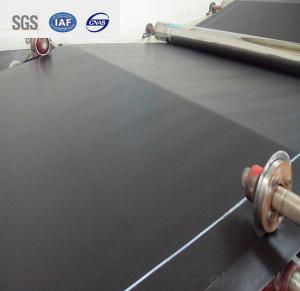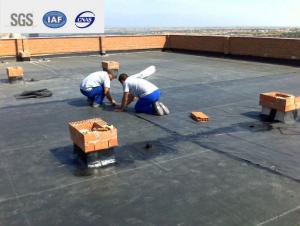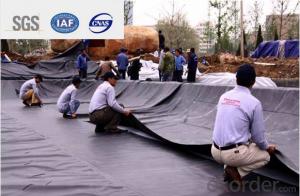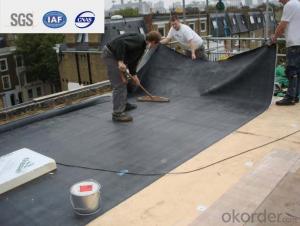EPDM Self-adhesive Waterproof Membrane for Roof
- Loading Port:
- Qingdao
- Payment Terms:
- TT OR LC
- Min Order Qty:
- 2000 m²
- Supply Capability:
- 800000 m²/month
OKorder Service Pledge
OKorder Financial Service
You Might Also Like
Description Of EPDM Rubber Waterproof Membrane:
1. EPDM waterproof membrane is made from ternary ethylene-propylene rubber, which is for waterproofing of exposed and non-exposed applications.
2. EPDM waterproof membrane production adopts the world-advanced equipment of cold feeding extrusion and continuous vulcanization technology.
3. EPDM waterproof membrane is of high elasticity among high polymer waterproof materials and becomes a world-popular waterproofing material.
Main Features of EPDM Rubber Waterproof Membrane:
1. Excellent physical and mechanical performance
2. High tearing resistance
3. Good deformation adaptability
4. High puncture resistance
5. High aging resistance
6. UV resistance
Specifications of EPDM Rubber Waterproof Membrane:
Material | EPDM Rubber |
Size | 1.2m (width)*20m (length) or customized, weldable type 2.05m or 4m width |
Thick | 1.2mm, 1.5mm, 2.0mm |
Type | Vulcanized & Weldable |
Pattern | Non-reinforced (homogeneous) |
Certificate | ISO9001/14001 |
Applications of EPDM Rubber Waterproof Membrane:
1.Roofs, Basement, Toilets
2. Industrial and civil building waterproofing
3. Geosynthetic liner for swimming pool, channels, irrigation system
4. Especially suitable for projects with high requirements in durability, anti-corrosion and deformation.
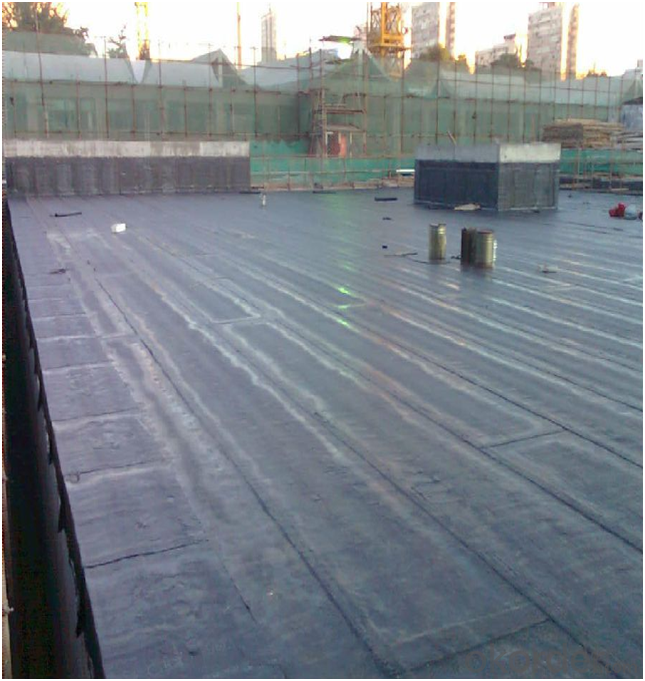


FAQ:
1. What are we supplying?
We are specialized in producing Colorful Asphalt Roof Shingle, SBS/APP modified bitumen waterproof membrane, Self adhesive bitumen waterproof membrane, PVC waterproofing membrane, EPDM rubber roofing membrane, Single Component Polyurethane Waterproof Coating, and Spray Polyurea Waterproof Coating.
2. How Many years experience do we have?
We have been exported to more than 20 countries in the past 15 years.
3. How long do we usually reply your request?
We always reply our customer within 24 hours.
- Q:Can a waterproofing membrane be used for a parking garage?
- Yes, a waterproofing membrane can be used for a parking garage. A waterproofing membrane is designed to provide a barrier against water infiltration, protecting the underlying structure from moisture damage. In a parking garage, where exposure to water and moisture is common due to rain, snow, and vehicle fluids, a waterproofing membrane can be a crucial component of the building envelope system. It can be applied to the concrete surfaces, including the floor and walls, to prevent water from seeping into the structure and causing deterioration, corrosion, or damage to the integrity of the parking garage. Additionally, a waterproofing membrane can also help to mitigate the risk of efflorescence, mold, and mildew growth, which can be common in damp environments. Therefore, using a waterproofing membrane in a parking garage is an effective way to ensure the long-term durability and functionality of the structure.
- Q:Can waterproofing membranes be used on rooftop terraces?
- Indeed, rooftop terraces can utilize waterproofing membranes. In fact, they are frequently employed to safeguard the terrace's structural integrity and prevent water damage to the underlying structure. Rooftop terraces are exposed to diverse weather conditions, encompassing rain, snow, and UV rays, which can result in leaks and deterioration. Waterproofing membranes function as a barrier, impeding water from permeating the surface and causing harm. These membranes are specifically engineered for outdoor usage and can endure the harsh conditions commonly encountered on rooftops. They are obtainable in various materials, such as modified bitumen, EPDM (ethylene propylene diene terpolymer), and PVC (polyvinyl chloride), allowing for flexibility in selecting the most suitable option for a specific terrace. Moreover, waterproofing membranes can be installed beneath a variety of terrace finishes, including pavers, tiles, and decking, offering a versatile solution for diverse design preferences. Overall, it is highly advisable to employ waterproofing membranes for rooftop terraces to ensure their longevity, durability, and resistance to water-related problems.
- Q:Can waterproofing membranes be used on shower walls?
- Yes, waterproofing membranes can indeed be used on shower walls. In fact, they are an essential component of shower construction to prevent water leakage and potential damage to surrounding areas. Waterproofing membranes create a barrier that prevents water from seeping through the walls and into the structural components of the shower. They are typically installed behind the tile or other wall covering materials to provide an extra layer of protection. Waterproofing membranes are designed to be flexible, durable, and resistant to moisture, ensuring that the shower walls remain watertight and free from any potential water damage.
- Q:Can a waterproofing membrane be used on precast nickel surfaces?
- Precast nickel surfaces can indeed benefit from the application of a waterproofing membrane. These membranes are specifically designed to create a barrier against moisture and thwart water infiltration. They can be effectively utilized on a variety of surfaces, such as concrete, metal, and even nickel. Nevertheless, it is crucial to ascertain that the waterproofing membrane is appropriate for use on nickel surfaces and is compatible with the particular type of precast nickel in question. To obtain guidance on the specific application and guarantee proper adhesion and effectiveness of the membrane on precast nickel surfaces, it is advisable to consult a professional waterproofing contractor or reach out to the manufacturer of the membrane.
- Q:Can a waterproofing membrane be applied on top of existing waterproofing systems?
- Indeed, it is possible to apply a waterproofing membrane onto existing waterproofing systems. In certain instances, it may be necessary to incorporate an extra layer of safeguard or improve the current waterproofing system. By applying a fresh waterproofing membrane on top, an additional barrier against water infiltration can be established, consequently prolonging the longevity of the waterproofing system. It is crucial to adequately prepare the existing surface prior to the application of the new membrane to ensure optimal adhesion and efficacy. Furthermore, seeking guidance from a professional or referring to the manufacturer's guidelines can offer specific recommendations regarding the compatibility and application process of the new waterproofing membrane.
- Q:Can a waterproofing membrane be used on nickel surfaces?
- Indeed, nickel surfaces can benefit from the use of a waterproofing membrane. These membranes are frequently employed in construction and building ventures to safeguard surfaces against water damage and moisture infiltration. They serve as a barrier, preventing water from seeping through the surface and causing harm. Like any other metal surfaces, nickel surfaces can be vulnerable to corrosion and water-induced damage. By applying a waterproofing membrane, the nickel surface can be effectively shielded from water and moisture, thereby prolonging its lifespan and preserving its integrity. However, it is crucial to guarantee that the chosen waterproofing membrane is suitable for use on nickel surfaces. Different membranes may have distinct compatibility requirements, which is why it is advisable to consult the manufacturer or a professional for guidance on proper application and compatibility.
- Q:Can a waterproofing membrane be installed underneath tile or other flooring materials?
- Yes, a waterproofing membrane can be installed underneath tile or other flooring materials to protect against moisture and water damage.
- Q:Can a waterproofing membrane be used for elevator shafts and stairwells?
- Yes, a waterproofing membrane can be used for elevator shafts and stairwells. Elevator shafts and stairwells are areas that are prone to moisture and water infiltration, especially in below-grade or high-moisture environments. Waterproofing membranes are designed to provide a barrier against water penetration and protect the structure from potential damage caused by moisture. When applied correctly, a waterproofing membrane can effectively prevent water from seeping into elevator shafts and stairwells, keeping them dry and free from water-related issues such as mold growth, deterioration of materials, and structural damage. These membranes are typically made from durable materials such as modified bitumen, PVC, or rubberized asphalt, which offer excellent waterproofing properties. It is important to choose a waterproofing membrane that is specifically designed for below-grade or high-moisture applications. These membranes should have high resistance to hydrostatic pressure, be capable of bridging cracks, and have long-term durability to withstand the constant exposure to moisture. Additionally, the installation of a waterproofing membrane in elevator shafts and stairwells should be done by trained professionals who have experience in waterproofing systems. This will ensure that the membrane is installed correctly, providing an effective barrier against water infiltration. In summary, a waterproofing membrane is a suitable solution for elevator shafts and stairwells as it can effectively prevent water penetration and protect the structure from moisture-related issues.
- Q:How does a waterproofing membrane handle structural cracks?
- A waterproofing membrane is designed to handle structural cracks by providing a barrier that prevents water from penetrating the cracks and causing damage to the underlying structure. The membrane is typically applied to the surface of a structure and acts as a protective layer that seals the cracks, preventing water infiltration. When a structural crack occurs, the waterproofing membrane is able to bridge the gap and create a waterproof seal. This is achieved through the use of flexible materials that can stretch and move with the structure, accommodating any movements or shifts that may occur over time. The membrane is also able to adhere to a variety of surfaces, ensuring a tight and secure bond that prevents water from seeping through the cracks. Additionally, some waterproofing membranes have the ability to self-heal. This means that if a crack does occur, the membrane has the ability to repair itself, closing the gap and maintaining its waterproofing capabilities. Overall, a waterproofing membrane is an effective solution for handling structural cracks as it provides a durable and flexible barrier that prevents water intrusion and protects the integrity of the structure. It is important to choose the appropriate type of membrane for the specific structural requirements and to ensure proper installation to achieve the desired waterproofing results.
- Q:Can a waterproofing membrane be used on precast concrete surfaces?
- Yes, a waterproofing membrane can be used on precast concrete surfaces. Precast concrete surfaces are commonly used in construction for various applications such as walls, floors, and roofs. These surfaces are prone to water penetration, which can cause damage and deterioration over time. To prevent this, a waterproofing membrane can be applied to the precast concrete surface. A waterproofing membrane is a thin layer of material that is designed to prevent the passage of water. It is typically made of materials such as bitumen, rubber, or PVC. The membrane is applied to the surface of the precast concrete and acts as a barrier, preventing water from seeping into the concrete. There are several benefits to using a waterproofing membrane on precast concrete surfaces. Firstly, it helps to extend the lifespan of the precast concrete by protecting it from water damage. Water can cause the concrete to crack, corrode reinforcement, and lead to the growth of mold and mildew. By applying a waterproofing membrane, these issues can be minimized or prevented altogether. Secondly, a waterproofing membrane can improve the overall performance of the precast concrete. By preventing water penetration, the membrane helps to maintain the structural integrity of the concrete. It also helps to maintain a dry and comfortable environment inside buildings by preventing water leakage. Lastly, a waterproofing membrane can provide additional protection against other elements such as chemicals and UV rays. Some membranes are designed to resist chemical exposure, which can be beneficial in industrial or commercial settings. Additionally, certain membranes have UV-resistant properties, which can help to prevent damage caused by prolonged exposure to sunlight. In conclusion, a waterproofing membrane can be used effectively on precast concrete surfaces to prevent water penetration and protect the concrete from damage. It is a cost-effective and efficient solution to ensure the durability and longevity of precast concrete structures.
1. Manufacturer Overview |
|
|---|---|
| Location | |
| Year Established | |
| Annual Output Value | |
| Main Markets | |
| Company Certifications | |
2. Manufacturer Certificates |
|
|---|---|
| a) Certification Name | |
| Range | |
| Reference | |
| Validity Period | |
3. Manufacturer Capability |
|
|---|---|
| a)Trade Capacity | |
| Nearest Port | |
| Export Percentage | |
| No.of Employees in Trade Department | |
| Language Spoken: | |
| b)Factory Information | |
| Factory Size: | |
| No. of Production Lines | |
| Contract Manufacturing | |
| Product Price Range | |
Send your message to us
EPDM Self-adhesive Waterproof Membrane for Roof
- Loading Port:
- Qingdao
- Payment Terms:
- TT OR LC
- Min Order Qty:
- 2000 m²
- Supply Capability:
- 800000 m²/month
OKorder Service Pledge
OKorder Financial Service
Similar products
New products
Hot products
Related keywords
